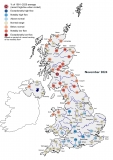Submitted by Lucy Barker on
May was a generally dry and settled month dominated by high pressure with the exception of a few wet interludes, and thunderstorm activity in the final fortnight. For the UK as a whole, May was warm (the second warmest for the UK in a record from 1910) and brought to a close the warmest spring in the Central England Temperature series from 1659. Rainfall was moderately below average at the national scale, but there was a reversal of the typical UK rainfall gradient: large parts of the north and west registered less than half of the average, whilst parts of the south and east were significantly wetter than average. Soil moisture deficits (SMDs) increased rapidly in May in the north and west; month-end deficits in some regions approached twice the average. In the south-east increases were more modest due to the above average rainfall, although exceptionally dry soils in early May caused some agricultural stress and the early onset of irrigation in some areas. River flows in the majority of catchments were below average throughout May and were notably or exceptionally low across much of Scotland and parts of central and southern England. Groundwater levels continued their seasonal recession at all sites and the majority were below normal or notably low, with the exception of south-west Scotland and north-east England. Reservoir stocks fell relative to average during May, substantially so in some impoundments in Scotland and northern England. Stocks in the majority of impoundments were below average, with anomalies greater than 10% in several index reservoirs and greater than 20% in Bewl and Teesdale. Despite the wetter May in the south-east, the effect of long-term rainfall deficits are evident in low river flows and groundwater levels, which are likely to persist into summer with continuing likelihood of environmental stress and localised pressure on water resources. In more responsive northern and western catchments, summer rainfall will be more influential; many areas with exceptionally low May river flows have seen a very wet first week of June.



